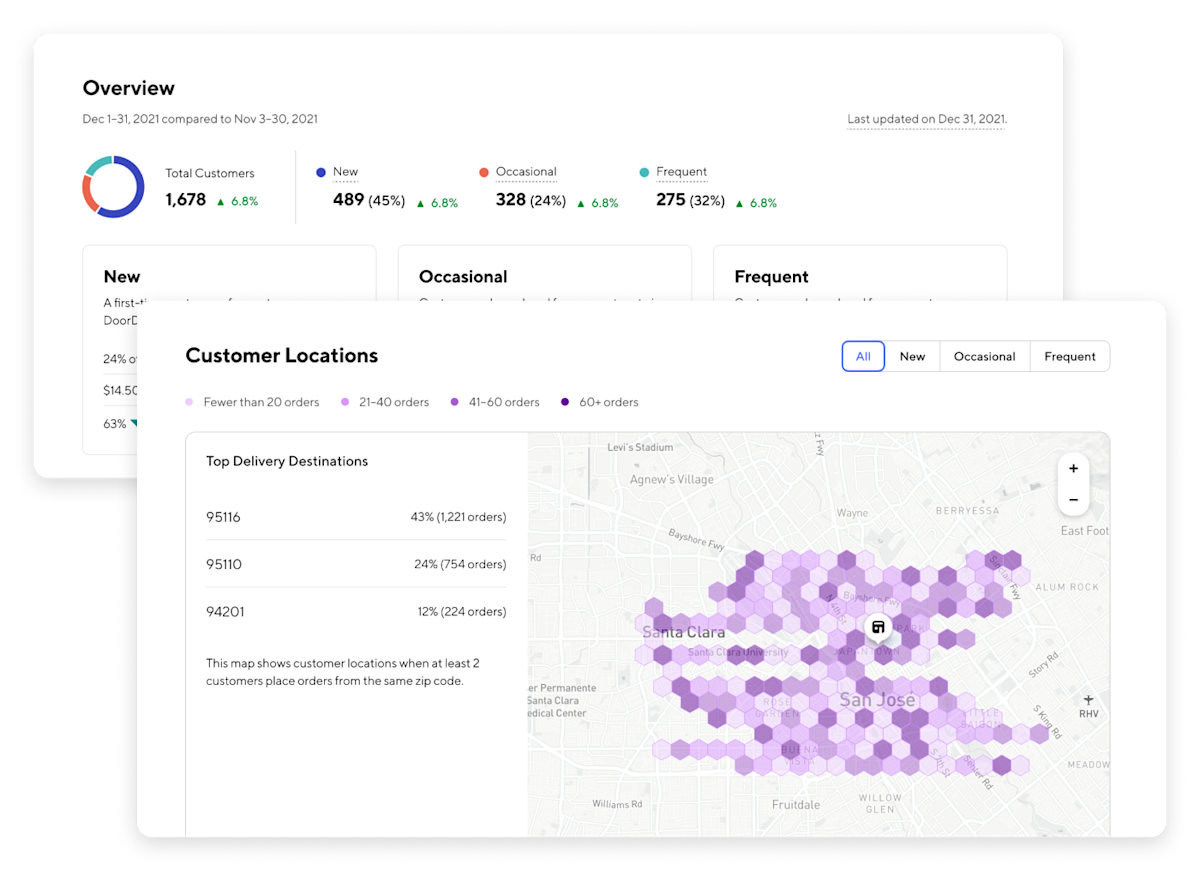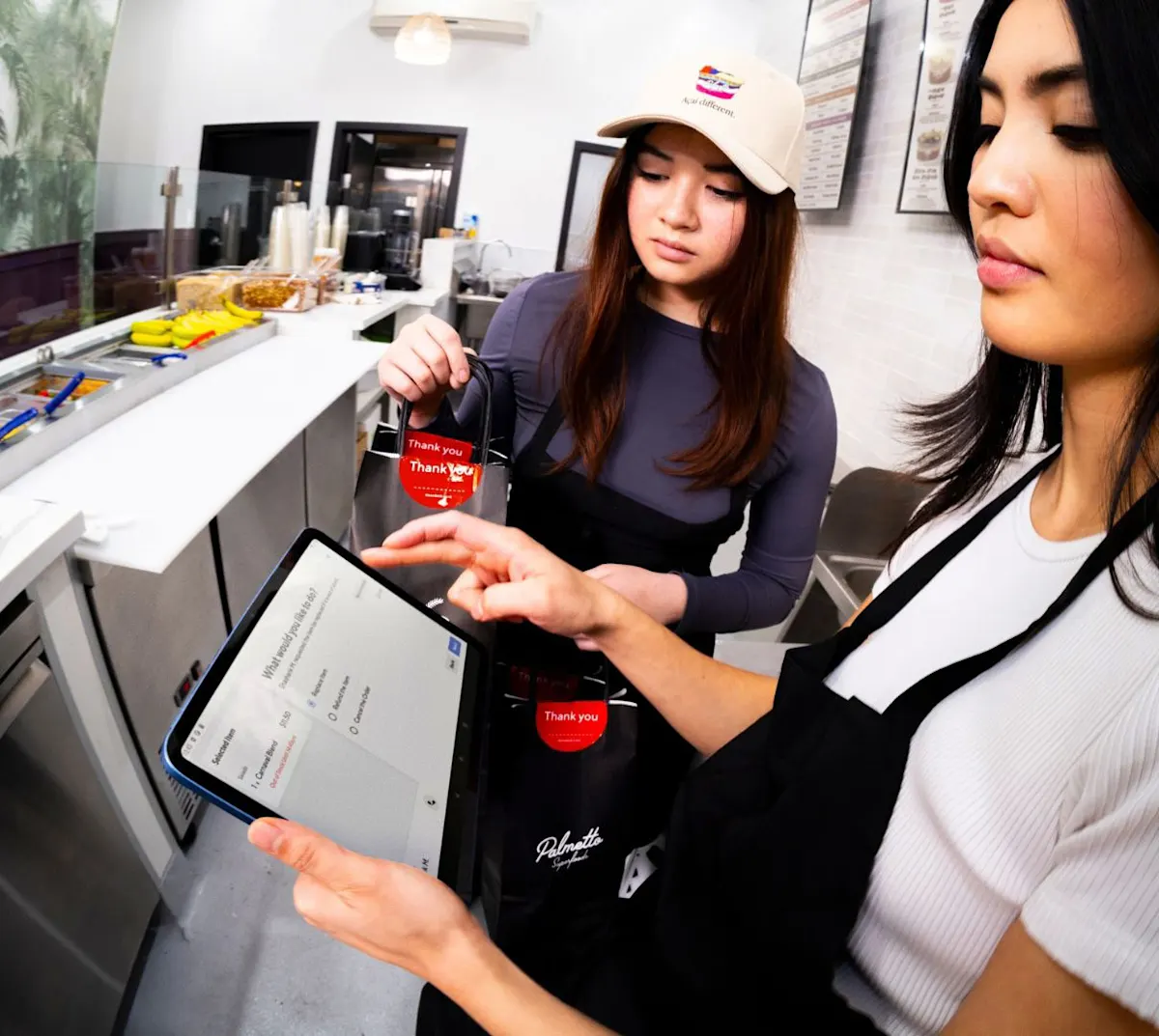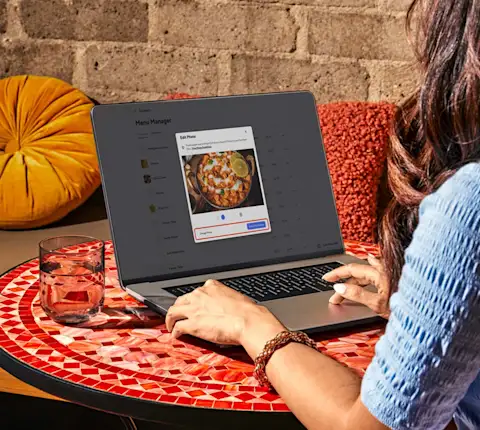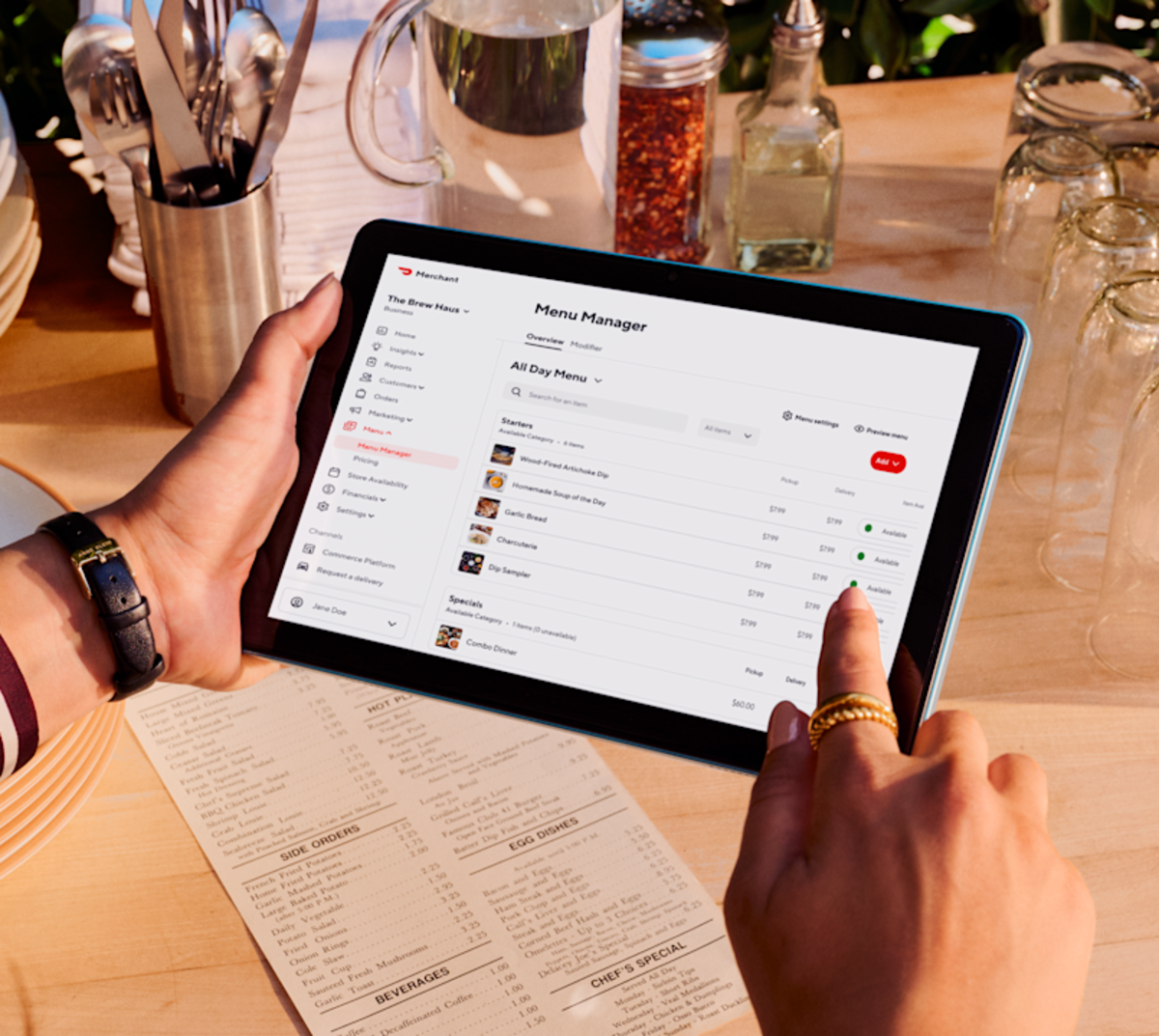Restaurant technology helps operators deliver seamless, convenient experiences that keep guests coming back—without sacrificing your unique food and flavor. Below are 13 tools, how they help your business, where they fit in your tech stack, and how to evaluate integration and impact.
Technology in restaurants at a glance
Here are some of the most impactful types of restaurant technology tools that business owners in the food and beverage industry are adding to their tech stack:
Point of sale systems
Integrated online ordering platforms
Kitchen display systems
Automated payroll tools
Employee scheduling apps
Inventory management systems
Email marketing platforms
Customer relationship management platforms (CRMs)
Omnichannel loyalty & direct-sales tools
Restaurant reservation systems
Restaurant phone answering systems
Self-serve ordering kiosks
Restaurant analytics platforms
13 types of restaurant technology that will make a difference
1. Point of sale systems
A touchscreen POS replaces the traditional cash register and autocalculates the bill. Mobile POS can route orders from the table or bar directly to kitchen or inventory management.
A touchscreen point-of-sale (POS) system can optimize multiple restaurant workflows, replacing the physical location where the point of sale happens: the traditional cash register. Upon completion of the meal, the entire bill is automatically calculated and presented to the customer in an elegant and easy-to-use payment interface.
For some mobile POS systems, the waitperson places the order through a touchscreen device at the table routing any food orders immediately to the kitchen, where the cooks can begin to prepare it, and any drink orders to the bar. Other systems can integrate with inventory management, subtracting the relevant ingredients in real-time, and even generating notifications when an item is running low and needs to be reordered.
DoorDash integrates with Toast, Square, and many other POS systems, allowing pickup and delivery orders to flow directly to the kitchen and removing the need for an extra tablet.
2. Integrated online ordering platforms
Key ingredients for a compelling online ordering platform include recognizable and personalized branding, appealing visual elements, ease of use, and, of course, a mobile-friendly format.
Today, it's easy for restaurants to add online ordering to their website and capture the sales potential of online traffic. With Online Ordering, you can create a seamless online ordering experience by adding delivery and pickup ordering to your existing website — easily converting website visitors into paying customers. Use your existing DoorDash Marketplace account to set up Online Ordering on DoorDash Commerce Platform, then start taking direct orders instantly. Commission starts at 0% with the Commerce Platform Starter Package, while the Boost and Pro Packages offer even more powerful tools to help you build a loyal customer base and grow your brand.
3. Kitchen display systems
Many restaurants have made the switch to kitchen display systems (KDS) because of the increased efficiency for the entire meal operation. With a display system, there's no longer any way to lose tickets or mess up their order. Each order is entirely visible to multiple members of the staff, and stays free of the sauce and grease stains that are the scourge of paper tickets. Orders move through the system in an organized and predictable manner, and — since everything is digital — at the end of the night, there's less paper to throw away.
4. Automated payroll tools
Automated payroll software saves restaurant management staff hours of their time when payroll day comes around. Top-rated payroll platforms, according to G2 reviews, like RUN by ADP, Paylocity, and Rippling include features like automatic tax calculations and deductions, quarterly or annual business reporting, and more.
By using automated, cloud-based payroll solutions, restaurateurs see better documentation, more accurate financials, faster payouts to employees, improved compliance, employee self-service features, and overall benefits to restaurant operations. And when considering that payroll errors can cost a 100-employee business more than $50,000 per year — trusted payroll software is a worthy investment. Prospective merchants and existing partners can also get discounted payroll tools.
5. Employee scheduling apps
More than a quarter of managers report spending three to five hours weekly on employee scheduling — some saying they spend up to 12 hours every week on this task — and 50% are still using paper schedules. It's time for an upgrade. Considering that missed shifts cost employers thousands of dollars per employee per year, investing in smart, automated scheduling systems is a win-win for employees and businesses.
Try a restaurant-specific solution like 7shifts, and consult with your employees to find out what they care most about in terms of app features.
6. Inventory management systems
Inventory management, like employee scheduling and payroll, is another time-consuming task for restaurant operators. Digital inventory management systems for restaurants, like LINGA Inventory, automate and streamline tedious counting, ordering, and tracking tasks for restaurant teams, and help managers forecast future orders.
These smart tools provide real-time visibility into inventory counts, help optimize menu management for more efficient ingredient use, and reduce labor costs.
7. Email marketing platform
Email marketing is one of the most dependable, low-cost ways to generate business and engage customers — the latest estimate says every $1 businesses invest in email marketing generates a $40 ROI. Look at easy-to-use email tools for small businesses like MailChimp, Constant Contact, Campaign Monitor, or HubSpot.
Restaurants can use email marketing to share specials, send promotions, and highlight featured staff through a monthly or weekly newsletter. Be sure to incorporate your restaurant branding and follow email marketing best practices.
8. Customer Relationship Management platforms (CRMs)
A CRM, or customer relationship management platform, is where restaurant teams can manage all of their contacts, whether those are past, current, or prospective customers, vendors, or partners. Options for this technology in restaurants, like the HubSpot CRM also include more marketing and sales tools built-in. Many CRMs are free, and include helpful learning guides on how to maximize the use of your CRM to grow your business.
9. Omnichannel loyalty & direct-sales tools
Customer relationships are built on more than a single transaction — and the DoorDash Commerce Platform helps restaurants deepen those relationships on their own direct channels.
With Commerce Platform, restaurants can launch an SEO-optimized, branded website where customers can order directly for pickup or delivery — all powered by DoorDash’s technology.
Commerce Platform Pro offers a new omnichannel loyalty program, which connects every guest interaction — in-store, online, or through the DoorDash app — into a single rewards experience. It also includes CRM and marketing automation tools to make it simple to run promotions, segment audiences, and deliver personalized offers. By owning their customer relationships and first-party data, merchants can strengthen loyalty, drive higher lifetime value, and reduce reliance on third-party traffic — turning every channel into an opportunity to grow their brand.
10. Digital restaurant reservation systems
Digital reservation systems allow guests to input and update their own information online, and oftentimes earn points while they do it. Popular reservation systems like OpenTable and Resy integrate with POS systems, capturing customer information and reducing manual work. Many platforms also offer a table management system to help with understanding capacity and table turnover.
11. Restaurant phone answering system
When your team spends more time on the phone answering simple questions like "What are your hours?" or "Are you open?" you miss out on opportunities for standout in-person service and more human interactions. But it is important for restaurants to be accessible by phone — after all, that's where large parties may reach out, or people looking to host special events.
Today, there are AI-powered restaurant phone answering systems that incorporate your business's branding and help answer questions before getting to your busy staff, saving businesses an average of 200+ hours each month. With smart tools that can recognize when a call needs to be urgently routed to a staff member, you'll never miss a potential customer, or have to sacrifice any level of customer service.
12. Restaurant self-serve kiosks
Digital kiosks allow customers to scroll through photos of each dish at their own pace, and even compare them side by side, to find the exact one to fulfill their current cravings. As an added bonus, digital kiosks help alleviate the current labor shortage since there's no need to interact with a staff member to place and purchase an order. Kiosks can also be programmed to upsell and cross-sell various dishes, bringing in larger revenues. Kiosk-maker GRUBBR's CEO, Sam Zietz reports that self-service kiosks bring in an average of 12% to 22% more revenue for businesses.
13. Restaurant analytics platforms

Today's restaurateur is data-obsessed. What's the most popular lunch item? Which day of the week does the restaurant generate the most sales? Restaurant analytics platforms allow you to capture all of the data points related to your business and analyze that information to generate insights to help you optimize for efficiency or growth.
DoorDash's Merchant Portal helps operators keep track of key metrics such as sales, net payouts, customer ratings, popular items, and more. Even more convenient, Business Manager is a mobile app that makes it easy to track orders, review performance metrics, and monitor Dasher locations, all from your phone. Operators are able to use these tools to access 24/7 support, mark items out of stock, update store hours, get analytics, and more.
How technology in restaurants helps business owners
Better team and customer communication
Restaurants can integrate both dine-in and online orders into one cohesive management system so kitchen staff can rely on one system instead of multiple printers and tablets.
Improved customer experience and brand loyalty
Technology like kiosks, loyalty programs and email marketing help personalize experiences, drive repeat visits, and turn new orders into regulars.
Tighter data security
Sustainability is smarter for your business. Reducing paper and food waste via forecasting software helps both eco-friendly and cost-efficient operations.
More sustainable business operations
Sustainability is smarter for your business. Reducing paper and food waste via forecasting software helps both eco-friendly and cost-efficient operations.
24/7 access to new customers & management tools
With direct-sales websites, apps, chat tools and mobile dashboards you stay open for business anytime, from anywhere.
31% of consumers report turning to a third-party app like DoorDash when choosing where to eat. A website with an email subscriber form, automated chat tools, and online reservations means that you are always open for business. You can bring new diners into your ecosystem at any time of the day, then keep your restaurant top of mind through social media, email marketing, and advertising — from anywhere, anytime.
What goes into a restaurant tech stack?
For your restaurant to operate smoothly and deliver a 5-star experience, you'll need to invest in an integrated restaurant tech stack that covers everything from back-end operations to customer-facing reservations and support.
Back-end restaurant operations technology solutions
Inventory management software
Staffing and scheduling tools
Kitchen display systems
Payroll and HR tools
Accounting and bookkeeping software
A content management system to host your website
CRMs
Email marketing platforms
Social media marketing tools
Automated phone systems
Payment tools
Restaurant analytics platforms
Customer-facing restaurant technology apps
Online ordering platforms
On-demand delivery service
Point of sale software
Self-serve ordering or kiosks
Omnichannel loyalty programs
Remember — all of your restaurant technology tools should integrate with one another to avoid duplicate work or manual data processing. Check out DoorDash Preferred Integration Partners to plan your tech stack.
How does your restaurant technology stack up?
As customer preferences and behavior continue to evolve, restaurateurs can adapt by embracing solutions and technologies in restaurants that can solve their day-to-day problems and deliver a better customer experience.
Today's customer has high standards and expects options that cater to a digital lifestyle — one that involves unique and memorable dining experiences on and off-premises. DoorDash technology and tools can help you manage your business on DoorDash and make data-driven decisions about your next menu update, location, and more.
Learn more about how DoorDash can help you grow sales and reach more customers in the Product Guide for Restaurants.
Learn more


